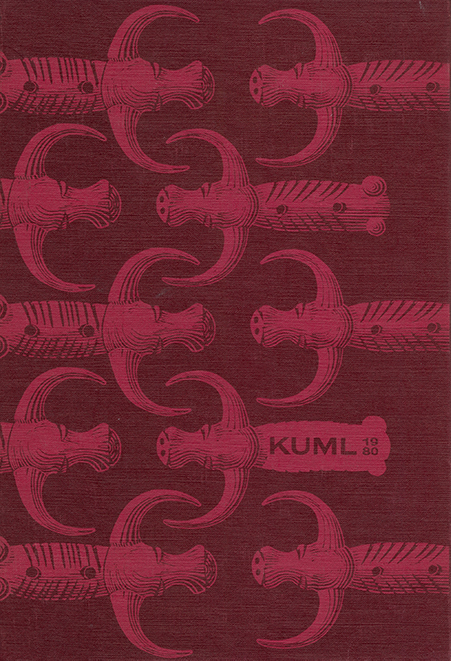Fredbjerg. A cart with bronze decoration from an Iron Age settlement in west Himmerland
DOI:
https://doi.org/10.7146/kuml.v29i29.107192Keywords:
Fredbjerg, cart, iron age, west himmerland, bronze decoration, settlementAbstract
Fredbjerg. A Cart with Bronze Decoration from an lron Age Settlement in West Himmerland
In the spring of 1969 two amateur archaeologists found the figures of a bull and two ducks, made of bronze, in a field in West Himmerland, Jutland (fig. 26-31). A small investigation of the find spot was soon carried out by the Aalborg Historical Museum, and this produced some more bronzes. In August 1969 the Prehistoric Museum, Moesgård, Århus, began a larger excavation of the site. This investigation, which lasted for three seasons ending in 1971, was led by Jens Aarup Jensen.
The three seasons of excavation at Fredbjerg resulted in the uncovering of a house dating from the late pre-Roman and Early Roman Iron Age (fig. 4-6). The house is an Iron Age farm of normal type with living area in the west end and stalling in the east end; a series of trenches suggests that it was part of a larger contemporaneous settlement. The bronze finds which sparked off the investigation probably lay originally in the fill of a drain, which runs in a northeasterly direction from the northern cobbled entrance of the house (fig. 4). Finds from this area are shown in fig. 26-56. During excavation more bronzes were found in the eastern end of the house (fig. 57-58); these are shown in figs. 59- 81. Stratigraphic observations indicate that these bronzes belong to the final phase of the house (fig. 7-8).
Some of the bronzes from the eastern end of the house derive from a cart, as is apparent from the similarity they display with other finds of carts from Denmark -in particular with one of the Dejbjerg carts. Fig. 76 shows the parts of the Fredbjerg cart that are preserved. These consist of the corner mountings for the body of a cart (fig. 67); the mountings from two cross-boards which, set on edge, ran transversally across the underframe of the cart (fig. 59-66); and two mountings from the rearward protruding ends of the arms of the underframe (fig. 70-73).
The cart from Langå on Fyn is not as well-preserved as those from Fredbjerg and Dejbjerg, as it comes from a cremation (16). The preserved parts do show, however, that the cart was of the same type as that from Fredbjerg and Dejbjerg I. In particular, the corner mountings from the cart bodies show that these three carts should be viewed as a group. These are not merely of the same type, but (insofar as they can be measured) are within a few millimetres of each other in size. The Langå find also includes two clamps of the same shape and size as those belonging to the cross-boards of the Fredbjerg cart and of Dejbjerg cart I.
The fifth and last Danish cart find belonging to this group is that from a cremation at Kraghede in north Jutland, and is the worst preserved (17). Some of the fragments can, however, be identified as the parts of a hub collar of the same type as those fitted to the wheel hubs of the Dejbjerg carts (18). Another fragment probably derives from an end mounting from one of the arms of the underframe.
Many of the mountings from Fredbjerg can be identified as the parts of a cart. This is, however, true of by no means all of them, and true of none of those found north of the house. Predominant among the bronzes from this area are several hundred decorated fragments of bronze sheet, and several bronze nails which fastened the sheet to a wooden underlay (fig. 39-56). It cannot be determined whether or not these mountings ever belonged to the cart. The same is true concerning the bull and the four duck figures. The two near-identical bull figures found respectively north of the house and in the stall end of it do, however, demonstrate that the cart finds belong together with the bronzes from the drain -although this does not necessarily mean that the bulls were ever mounted on the cart.
On the basis of the pottery (fig. 10-22) and stratigraphic observations (fig. 7-8) made during excavation, it can definitely be established that the Fredbjerg cart was deposited during the early Roman Iron Age -probably in the 1st century AD. This is somewhat later than the late pre-Roman Iran Age date usually ascribed to such carts. Besides the Danish examples, two further carts are known from northern Europe: from Rosenfelde in east Pomerania (19) and Husby near Flensburg (20). Both these graves are also placed in the pre-Roman Iron Age.
To sum up, therefore, it can be established that all four north European carts with burials belong to a late part of the pre-Roman Iron Age. The Fredbjerg cart, because of its close similarity to the Langå cart, must be regarded as having been constructed in the preRoman Iron Age, but the find circumstances indicate that it did not become part of the archaeological deposits until the early Roman Iron Age -when it was at least 100 years old. This could also be the case for the carts from Dejbjerg.
Stig Jensen
Downloads
Published
How to Cite
Issue
Section
License
Fra og med årgang 2022 er artikler udgivet i Kuml med en licens fra Creative Commons (CC BY-NC-SA 4.0).
Alle tidligere årgange af tidsskriftet er ikke udgivet med en licens fra Creative Commons.


